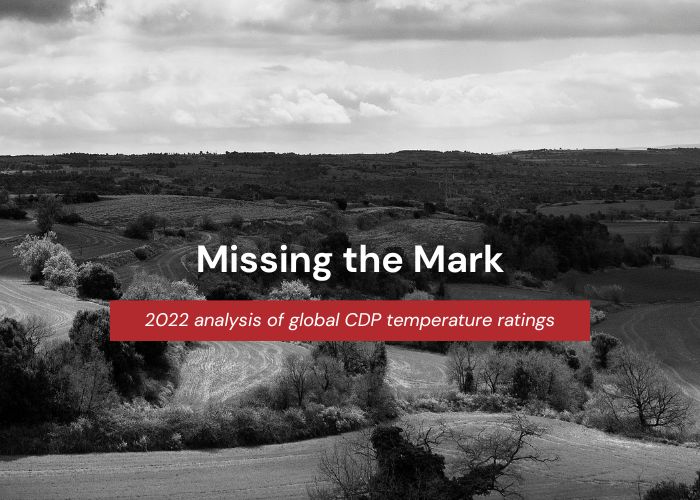
Submitted by selincene on September 13, 2022
As we approach COP27, this report uses CDP’s latest temperature ratings to assess whether current corporate emissions reduction targets are ambitious enough to meet the Paris Agreement’s 1.5°Celsius goal. CDP temperature ratings compare our comprehensive dataset of publicly disclosed corporate emissions target disclosures, covering more than 4,000 companies globally, with science-based global warming trajectories. The report was prepared in partnership with Oliver Wyman.
G7 companies on the path to a 2.7°C temperature increase
Amid a challenging global context of energy insecurity, rising inflation, and extreme weather in many regions, COP27’s goal to keep the Paris Agreement’s 1.5°Celsius target alive is more critical than ever.
The G7’s private sector has an important role to play in that effort. Strong momentum in 2021, particularly in the runup to last year’s COP26, saw the number of corporates committing and setting climate targets increase rapidly. Yet, our analysis shows that the greenhouse gas (GHG) emissions reduction targets publicly disclosed by companies in G7 economies are still only ambitious enough to align with a 2.7°C decarbonization pathway — or 2.4°C if emissions from corporate supply chains, known as Scope 3 emissions are excluded. Both are still well above the Paris Agreement’s goal to keep Earth’s temperature rise at or below 1.5°C — the upper-temperature limit that science demands to avoid the most catastrophic environmental impacts.
Across the G7, the countries with the best-performing corporate sectors are all European. Europe’s relative outperformance reflects the wider uptake of emissions reduction target-setting by companies, as well as structural differences in the makeup of the economies.
The highest temperatures are found in the G7 countries where the fewest companies have adopted targets. In Canada, which is looking at a rise of 3.1°C, 88% of all reported emissions come from companies lacking targets. In the United States, with companies aligned with a 2.8°C increase, over half of emissions not covered by targets are from the fossil fuel sector.
Europe is improving, but still running hot
Following an 85% increase in the number of European companies with science-based targets last year, over half (51%) based on market capitalization have now set targets through the Science-Based Targets Initiative (SBTi).4 This means that the targets have been developed consistent with pathways for carbon reduction anchored in climate science and approved by the SBTi. The most recent SBTi Progress Report found that companies with science-based targets decarbonize significantly faster than companies without targets.
This fast progress in Europe has “cooled” the temperature of the European economy by 0.3°C since 2021. Still, the emissions reduction targets publicly disclosed by European companies are now aligned with a 2.4°C decarbonization pathway, or 2.2°C if corporate Scope 3 emissions (value chain) are excluded. Germany, Italy, and the Netherlands — all with targets that support 2.2°C — have the best-performing corporate sectors, inclusive of all value-chain emissions.
However, despite this progress, the average temperature ratings for corporates remain well above 1.5°C across all major European economies.
Focusing on Scope 1 and 2 emissions, where emissions reporting is more robust and target-setting more widespread, the power and infrastructure sectors perform best. Together, the two sectors represent 29% of all European Scope 1 and 2 emissions and have temperature ratings of 1.9°C and 2°C, respectively.
By contrast, companies in the materials and transportation services sectors lag behind. When combined, they represent more than 40% of reported Scope 1 and 2 emissions and have significantly higher temperature ratings of 2.4°C and 2.6°C, respectively.
Other regions aren’t keeping up with Europe
Looking beyond the G7, European corporates score ahead of their counterparts in Asia and North America across industries. Based on Scope 1 and 2 emissions, companies headquartered in North America are collectively on a path to a 2.5°C rise in temperature, while companies headquartered in Asia are on a path to 3°C. Both are significantly higher than Europe’s 2.2°C.
Some of the largest differences across regions are in the power generation and infrastructure sectors. Europe’s 1.9°C power sector, for instance, compares with 2.1°C in North America and 3°C in Asia. This differential reflects the important role of long-term domestic policies supporting decarbonization in these strategically important sectors.
The materials sector, by contrast, is more global in nature, and companies face common challenges in reinventing industrial processes, such as steel and cement production. Nonetheless, differences exist in the ambition level of companies across regions: Europe’s 2.4°C-aligned sector compares with 2.6°C in North America and 2.9°C in Asia.
The analysis shows warmer temperature ratings in nearly all sectors and regions when all value-chain emissions (Scope 1, 2, and 3) are included. This reflects that Scope 3 emissions, concentrated largely in supply chains and the use of end products, are harder to measure and manage. As a result, targets are much less widespread and also less ambitious.
In previous CDP-Oliver Wyman research, only 53% of high-impact companies were found to be disclosing data on their most important Scope 3 categories, usually following emissions from purchased goods and services or how products are used. While 43% of global Scope 1 and 2 emissions are covered by targets, only 26% of global Scope 3 emissions are covered. Yet, these emissions are critical: They represent, on average, six times the volume of Scope 1 and 2 emissions combined. In the US, this may be changing if the Securities and Exchange Commission adopts a proposed rule that will compel many companies to disclose Scope 3 emissions.
Conclusion
Growing numbers of corporates are setting credible, science-based targets to reduce their emissions, and this is starting to have a real impact on expected emissions pathways. Importantly, this is also helping to spur bolder public policies in several major economies, notably the US and Australia.
Yet, progress remains patchy. Not enough companies have embraced target setting and those that have are not nearly ambitious enough in their plans to reduce emissions. Even among those with targets, there are too many that are neglecting to address Scope 3 emissions.
To keep the goal of 1.5°C meaningful and viable, more progress is needed in spreading best practices from those companies taking the lead. At the same time, those advanced companies also must push harder for more rigor in their own targets.
To reach the whole report please click here.





